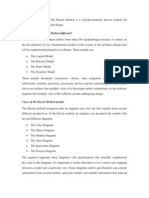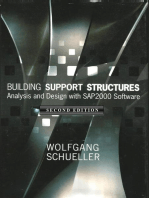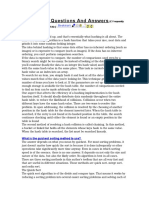0 ratings0% found this document useful (0 votes)
23 viewsObject Oriented Software: Ame: Fiyory Tassew D:FNCS/UR9656/11
Object Oriented Software: Ame: Fiyory Tassew D:FNCS/UR9656/11
Uploaded by
Fiyory TassewThe document summarizes three object-oriented methodologies:
1. The Booch method uses a process of identifying objects, semantics, and relationships to model classes and interactions. It covers common object-oriented concepts except placement of classes and attributes.
2. The OMT method uses three models - object, dynamic, and functional - to describe classes, behavior, and data flow. It addresses identifying classes, attributes, relationships, and behavior through specific steps.
3. The OOSE method takes a holistic approach covering the software lifecycle. It identifies domain objects, use cases, and design objects to specify behavior and dynamic behavior using interaction diagrams. It distinguishes between class types and addresses various development aspects
Copyright:
© All Rights Reserved
Available Formats
Download as DOCX, PDF, TXT or read online from Scribd
Object Oriented Software: Ame: Fiyory Tassew D:FNCS/UR9656/11
Object Oriented Software: Ame: Fiyory Tassew D:FNCS/UR9656/11
Uploaded by
Fiyory Tassew0 ratings0% found this document useful (0 votes)
23 views4 pagesThe document summarizes three object-oriented methodologies:
1. The Booch method uses a process of identifying objects, semantics, and relationships to model classes and interactions. It covers common object-oriented concepts except placement of classes and attributes.
2. The OMT method uses three models - object, dynamic, and functional - to describe classes, behavior, and data flow. It addresses identifying classes, attributes, relationships, and behavior through specific steps.
3. The OOSE method takes a holistic approach covering the software lifecycle. It identifies domain objects, use cases, and design objects to specify behavior and dynamic behavior using interaction diagrams. It distinguishes between class types and addresses various development aspects
Original Title
Object Oriented Methodologies
Copyright
© © All Rights Reserved
Available Formats
DOCX, PDF, TXT or read online from Scribd
Share this document
Did you find this document useful?
Is this content inappropriate?
The document summarizes three object-oriented methodologies:
1. The Booch method uses a process of identifying objects, semantics, and relationships to model classes and interactions. It covers common object-oriented concepts except placement of classes and attributes.
2. The OMT method uses three models - object, dynamic, and functional - to describe classes, behavior, and data flow. It addresses identifying classes, attributes, relationships, and behavior through specific steps.
3. The OOSE method takes a holistic approach covering the software lifecycle. It identifies domain objects, use cases, and design objects to specify behavior and dynamic behavior using interaction diagrams. It distinguishes between class types and addresses various development aspects
Copyright:
© All Rights Reserved
Available Formats
Download as DOCX, PDF, TXT or read online from Scribd
Download as docx, pdf, or txt
0 ratings0% found this document useful (0 votes)
23 views4 pagesObject Oriented Software: Ame: Fiyory Tassew D:FNCS/UR9656/11
Object Oriented Software: Ame: Fiyory Tassew D:FNCS/UR9656/11
Uploaded by
Fiyory TassewThe document summarizes three object-oriented methodologies:
1. The Booch method uses a process of identifying objects, semantics, and relationships to model classes and interactions. It covers common object-oriented concepts except placement of classes and attributes.
2. The OMT method uses three models - object, dynamic, and functional - to describe classes, behavior, and data flow. It addresses identifying classes, attributes, relationships, and behavior through specific steps.
3. The OOSE method takes a holistic approach covering the software lifecycle. It identifies domain objects, use cases, and design objects to specify behavior and dynamic behavior using interaction diagrams. It distinguishes between class types and addresses various development aspects
Copyright:
© All Rights Reserved
Available Formats
Download as DOCX, PDF, TXT or read online from Scribd
Download as docx, pdf, or txt
You are on page 1of 4
ASSIGNMENT
2021
Submitted on: 26-11-2021
Proposed to: Instructor Tadegew Bogale
OBJECT ORIENTED
SOFTWARE
ENGINEERING
ASSIGNMENT
NAME: FIYORY TASSEW
ID:FNCS/UR9656/11
OBJECT ORIENTED
METHODOLOGIES
Object Oriented Methodology (OOM) is a system development approach encouraging and
facilitating re-use of software components. With this methodology, a computer system can be
developed on a component basis which enables the effective re-use of existing components and
facilitates the sharing of its components by other systems. The object oriented design, object
modeling technique, and object oriented software engineering methods are all object-oriented
methods that have received a broad acceptance in the field object-oriented software
development. These three methods have a lot in common and the differences are more in terms
of detail, emphasize and comprehensiveness.
1. Object Oriented Design by Booch
The Booch method uses the following process: Identify objects, Identify semantics of the
objects, Identify relationships and finally implement and iterate. Identifying objects is the
step which involves finding key abstractions in the problem domain and the first set of
classes and attributes. During the identification of the semantics step, the developer has to
decide on the behavior of the classes and the interaction between classes and objects.
Here state transition diagrams are used to model the states for the object. The
specification of behavior is modelled using timing diagrams in conjunction with object
diagrams. In the identification of relationships step both static and dynamic relationships
are modelled. The relationships covered are uses, instantiates, inherits (generalization)
and metaclass for classes and for objects there are association and containing
(aggregation) relationships. Regarding placement of class, attributes and behavior the
Booch method only handles the placement of behavior. The final step implement and
iterate handles the implementation and it also covers the optimization of classes aspect.
The Booch method covers all the commonalities of an object-oriented method except
placement of classes and attributes.
2. Object modeling techniques by Rumbaugh
The OMT method consists of three models, the object model, the dynamic model and the
functional model. The object model describes objects and classes, their attributes,
methods and relationships. Relationships, such as association, aggregation and
inheritance is also captured. The process for developing the object model comprises of
the following steps: Identify objects and classes, Prepare a data dictionary, Identify
association and aggregation relationships, Identify attributes, Organize and simply classes
using inheritance, Verify access paths, Iterate and refine the model and finally, Group
classes into modules. Regarding identification of classes, attributes and behaviour OMT
have specific steps for each identification. Identification of relationships is covered by the
Identify association and aggregation relationships and Organize and simplify... steps.
Other relationships in the method are instantiation and metaclass. OMT does not
explicitly addresses the placement of classes, attributes and behaviour. But, in the step
organize and simplify classes, this is addressed informally. The temporal interaction
between actions is portrayed in the dynamic model. This model focuses on showing
external control rather than algorithmic behaviour or internal control. It consists of
events, states and operations and can be structured in a hierarchical way. Typical
interaction sequences are described by scenarios and then more formally using event-
trace diagrams. The states of the objects are modelled through state diagrams using Harel
state charts. The specification of dynamic behaviour is captured by the event-trace
diagrams. The value transformations and data flow are modelled in the functional model
which consists of data flow diagrams. The three models are developed separately during
the analysis phase and they are integrated into the object model during the design phase.
During the design phase the optimization of classes is addressed.
3. Object oriented software engineering by Jacobson
The OOSE method differs from the other three methods in the way that it takes a more
holistic approach meaning addresses the whole software life-cycle to software
development. The methods consist of four processes, requirement analysis, design,
implementation and test. The requirement analysis and design processes are the two most
relevant in this context. The requirement analysis activities are define the potential actors
(an actor is the one will use the system), Identify domain objects and relationships (a
domain object is an object in the problem domain), Find use-cases based on the
requirements specification and actors’ need and describe the use-cases in detail. A use-
case is a flow of events in the system, including the interaction with the surroundings (the
actors). The design work consists of two main activities, find the design object from the
requirements analysis model and Adjust the design model to the implementation
environment. The first activity includes identification of design objects from the use-case
descriptions and outlining of the design objects attributes, associations and behaviour.
The distribution of the use-cases behaviour to objects is also made here. Identification of
classes, attributes and relationships is made in the identify domain objects and
relationships activity in the requirement analysis process. The relationships covered are
inheritance, acquaintance (association), consists-of (aggregate) and a communication
association. The activity defines use-cases in combination with the distribution of use-
cases step in the Identification of design objects from use-cases addresses the
specification of behaviour and the latter also the specification of dynamic behaviour. In
the specification of dynamic behaviour interaction diagrams (similar to event-traces) are
used to describe the interaction. Placement of attributes and behaviour is dealt with in
various detail both in the requirement analysis and design processes. Regarding
placement of classes OOSE makes a distinction between semantic objects, interface
objects and control objects. Optimization of classes is performed in the Adjust the design-
model to the implementation environment activity. OOSE differs to the other methods in
that it address a number of aspects of software development example testing,
management issues. There are special sections about data-base and real-time
specializations of the method. The method have strong emphasis on traceability and
product-oriented view on software development.
You might also like
- Object Oriented Analysis and Design NotesDocument62 pagesObject Oriented Analysis and Design Notesvraj patelNo ratings yet
- Section 5 Quiz PLSQLDocument4 pagesSection 5 Quiz PLSQLOvie Widiyastuti0% (1)
- (IOP Concise Physics) Liengme, Bernard V - Excel VBA For Physicists A Primer-IOP Publishing (2016)Document92 pages(IOP Concise Physics) Liengme, Bernard V - Excel VBA For Physicists A Primer-IOP Publishing (2016)DwinaRahmayani100% (1)
- Object Oriented MethodologiesDocument4 pagesObject Oriented MethodologiesFiyory TassewNo ratings yet
- Object Oriented AnalysisDocument3 pagesObject Oriented AnalysisHamza AtifNo ratings yet
- Translation Material - 2018490146 - AMIN MUNTASIR IBNEDocument11 pagesTranslation Material - 2018490146 - AMIN MUNTASIR IBNEMuntasir Ibne AminNo ratings yet
- UML Some Viva Question - Shree Ram College BhandupDocument41 pagesUML Some Viva Question - Shree Ram College BhandupUnknown100% (1)
- Object-Oriented Analysis and Design (OOAD) Is A SoftwareDocument4 pagesObject-Oriented Analysis and Design (OOAD) Is A SoftwarenagulanathanNo ratings yet
- Chapter 1 IntroductionDocument16 pagesChapter 1 Introductionkshitijsriram2683No ratings yet
- Rumbaugh's Object Modelling Technique (OMT) - : Unit Ii Object Oriented Methodologies 9Document71 pagesRumbaugh's Object Modelling Technique (OMT) - : Unit Ii Object Oriented Methodologies 9ASUIUX DesignerNo ratings yet
- Unit - 1 Q-Explain Object Oriented Development Life Cycle?Document13 pagesUnit - 1 Q-Explain Object Oriented Development Life Cycle?NiveditaLeoNo ratings yet
- Advantages of Object-Oriented ArchitectureDocument18 pagesAdvantages of Object-Oriented ArchitecturesaraNo ratings yet
- Chapter 1Document27 pagesChapter 1YE' JEMBRU Lige EshetuNo ratings yet
- Introduction To Object-OrientationDocument9 pagesIntroduction To Object-Orientationakyadav123No ratings yet
- OOAD Unit 5Document30 pagesOOAD Unit 5Charveer “CHARVEERTV” tvNo ratings yet
- Modeling TechniqueDocument11 pagesModeling TechniqueharshitNo ratings yet
- OOMD Notes Part ADocument74 pagesOOMD Notes Part ANitin Talhar50% (2)
- Spiral Model of The Software ProcessDocument17 pagesSpiral Model of The Software ProcessAmol MNo ratings yet
- Object Oriented Methodology Life Cycle ModelDocument5 pagesObject Oriented Methodology Life Cycle Modelkaliya420No ratings yet
- What Is Object Orientation: ObjectsDocument3 pagesWhat Is Object Orientation: ObjectssalehashaikhNo ratings yet
- C++ Unit-1 NotesDocument10 pagesC++ Unit-1 NotesMohd NadeemNo ratings yet
- OOAD Model TypesDocument16 pagesOOAD Model TypesNitish RanaNo ratings yet
- Mca 503Document150 pagesMca 503logNo ratings yet
- Phases in Object-Oriented Software DevelopmentDocument20 pagesPhases in Object-Oriented Software DevelopmentAlvo KamauNo ratings yet
- Bit 223 Object Oriented Analysis and DesignDocument61 pagesBit 223 Object Oriented Analysis and DesignArtNo ratings yet
- Scsa1401 - Ooase - Unit IDocument31 pagesScsa1401 - Ooase - Unit IG.AkshayaNo ratings yet
- 456 Business Process Models From Object Behaviour ModelsDocument24 pages456 Business Process Models From Object Behaviour ModelsSuongNgocNo ratings yet
- Oomethodologies-Lecture 5Document20 pagesOomethodologies-Lecture 5Dex TreNo ratings yet
- Unit-7 (Object Oriented Analysis and Design)Document18 pagesUnit-7 (Object Oriented Analysis and Design)सुरज पौडेलNo ratings yet
- Software Engineering Unit 4 .......... 11-August-2021Document93 pagesSoftware Engineering Unit 4 .......... 11-August-2021project group 87No ratings yet
- Ooa UdatedDocument9 pagesOoa UdatedMuhammad AuwalNo ratings yet
- Andes X S11 G3 Stevan A.Document4 pagesAndes X S11 G3 Stevan A.Stevan AyubNo ratings yet
- OoadDocument169 pagesOoad5zuNo ratings yet
- Object Oriented Modeling and DesignDocument56 pagesObject Oriented Modeling and DesignRitesh KumarNo ratings yet
- MSC - It - Object Oriented Analysis and DesignDocument243 pagesMSC - It - Object Oriented Analysis and DesignmkvmemberNo ratings yet
- Ooad Unit-VDocument18 pagesOoad Unit-VAbi KNo ratings yet
- Unit 1 Introduction To Object Oriented Modeling: Structure Page NosDocument14 pagesUnit 1 Introduction To Object Oriented Modeling: Structure Page NosexoticaashimaNo ratings yet
- 4ObjectOrientedMetricsinSoftwareDevelopment IJCEAFEB15Document11 pages4ObjectOrientedMetricsinSoftwareDevelopment IJCEAFEB15Laiba TariqNo ratings yet
- Oomd BasicsDocument18 pagesOomd BasicsVignesh KarthiNo ratings yet
- KCC2013Document4 pagesKCC2013Romisaa KhaledNo ratings yet
- 1 2 3 Units OoadDocument21 pages1 2 3 Units Ooadsamiksha5singhalNo ratings yet
- Ms-032 Object Oriented Analysis and DesignDocument187 pagesMs-032 Object Oriented Analysis and DesignJames JonesNo ratings yet
- OOMD Module 1Document23 pagesOOMD Module 1anilkali2004No ratings yet
- Master of Computer Application (MCA) - Semester 5 MC0083 - Object Oriented Analysis & Design Using UML Assignment Set - 1Document8 pagesMaster of Computer Application (MCA) - Semester 5 MC0083 - Object Oriented Analysis & Design Using UML Assignment Set - 1Priya SagiNo ratings yet
- MCS032 Object Oriented Modeling and UMLDocument1 pageMCS032 Object Oriented Modeling and UMLPayal SinghNo ratings yet
- Object Oriented Analysis and Design Class NotesDocument72 pagesObject Oriented Analysis and Design Class NoteshazmonkingaNo ratings yet
- Unit-3 Notes OosdDocument20 pagesUnit-3 Notes Oosdyou • were • trolled0% (1)
- Lab 1 Introduction To Object Oriented Software Engineering and Object Orientation in UmlDocument9 pagesLab 1 Introduction To Object Oriented Software Engineering and Object Orientation in Umlkpk kpkNo ratings yet
- BC0057Document7 pagesBC0057RaviKumarNo ratings yet
- Conceptual Cohesion of Classes in Object Oriented SystemsDocument7 pagesConceptual Cohesion of Classes in Object Oriented Systemsmeena meenakshiNo ratings yet
- Object-Oriented Systems: Object-Oriented Analysis and Design (OOAD) Is ADocument3 pagesObject-Oriented Systems: Object-Oriented Analysis and Design (OOAD) Is AaamensankNo ratings yet
- What Makes The Booch Method Different?Document32 pagesWhat Makes The Booch Method Different?bhargavavngotNo ratings yet
- R2017 Ooad Unit-5Document30 pagesR2017 Ooad Unit-5SteffiNo ratings yet
- Lecture-11 Object Oriented ParadigmDocument10 pagesLecture-11 Object Oriented Paradigmmuneeb javed javedNo ratings yet
- Object Oriented Analysis and DesignDocument33 pagesObject Oriented Analysis and DesignShwetank SharmaNo ratings yet
- SEPM Module 2Document37 pagesSEPM Module 2deepika seranNo ratings yet
- An Oop Nots - 020022Document18 pagesAn Oop Nots - 020022Abdul-halim HafidhNo ratings yet
- BC0057-Object Oriented Analysis & DesignDocument7 pagesBC0057-Object Oriented Analysis & DesignManit Happy SharmaNo ratings yet
- Geometric Feature Learning: Unlocking Visual Insights through Geometric Feature LearningFrom EverandGeometric Feature Learning: Unlocking Visual Insights through Geometric Feature LearningNo ratings yet
- Building Support Structures, 2nd Ed., Analysis and Design with SAP2000 SoftwareFrom EverandBuilding Support Structures, 2nd Ed., Analysis and Design with SAP2000 SoftwareRating: 4.5 out of 5 stars4.5/5 (15)
- DM QuesDocument5 pagesDM Quesnarendran.p1977No ratings yet
- C Interview Questions and Answers: What Is Hashing?Document4 pagesC Interview Questions and Answers: What Is Hashing?Karthik KartzNo ratings yet
- Issue 1 MMNR Short DumpDocument6 pagesIssue 1 MMNR Short DumppookusmasNo ratings yet
- 29 Common Beginner Python Errors PDFDocument1 page29 Common Beginner Python Errors PDFKushan ShahNo ratings yet
- Spring 2010 MidTerm OPKST CS101Document9 pagesSpring 2010 MidTerm OPKST CS101cs619finalproject.comNo ratings yet
- Comprog 3 - ADocument3 pagesComprog 3 - Aerikalast.acadNo ratings yet
- Compo02 Chapter 5Document3 pagesCompo02 Chapter 5JUN GERONANo ratings yet
- Fletcher Reeves HandoutDocument6 pagesFletcher Reeves Handoutloweschevy12No ratings yet
- Xpress Optimizer Refernce ManualDocument485 pagesXpress Optimizer Refernce ManualMaderos CCNo ratings yet
- ADSA Lecture Unit II Ch1Document45 pagesADSA Lecture Unit II Ch1ranjit.e10947No ratings yet
- Arrays Are Used To Store Multiple Values in A Single Variable, Instead of Declaring Separate Variables For Each ValueDocument7 pagesArrays Are Used To Store Multiple Values in A Single Variable, Instead of Declaring Separate Variables For Each ValueGabriel V. MarinasNo ratings yet
- Postgresql Plpython CheatsheetDocument1 pagePostgresql Plpython Cheatsheetlopes_ericNo ratings yet
- Subject: C' Programming For Problem Solving Subject Code: 18CPS23Document17 pagesSubject: C' Programming For Problem Solving Subject Code: 18CPS23GOPINATHNo ratings yet
- Sukesh Practical FileDocument26 pagesSukesh Practical FilejonyNo ratings yet
- VHDL For Synthesis: Summary Notes From: Appendix A: Synthesis The Designer's Guide To VHDL, 2 EdDocument33 pagesVHDL For Synthesis: Summary Notes From: Appendix A: Synthesis The Designer's Guide To VHDL, 2 EdsridharmirNo ratings yet
- Lesson 1A - First Java Program "Hello World" With DEBUGGING ExamplesDocument41 pagesLesson 1A - First Java Program "Hello World" With DEBUGGING ExamplesJarrett LindseyNo ratings yet
- CNN Lab ManualDocument29 pagesCNN Lab ManualMax WatsonNo ratings yet
- Subject:: Microcontroller and Embedded Systems Laboratory 18CSL48 2 0:2:2Document17 pagesSubject:: Microcontroller and Embedded Systems Laboratory 18CSL48 2 0:2:2rakshithaNo ratings yet
- Backorder ProcessingDocument4 pagesBackorder ProcessingKottu ArvindNo ratings yet
- Python Programming InstallationDocument11 pagesPython Programming InstallationEnz San Pedro VillenaNo ratings yet
- Lab Manual-2Document106 pagesLab Manual-2Hanan AslamNo ratings yet
- Abap On Hana From Analysis To OptimizationDocument27 pagesAbap On Hana From Analysis To Optimizationvtheamth100% (1)
- Experiment #4: Restricting and Sorting Data: Student's Name: Semester: DateDocument7 pagesExperiment #4: Restricting and Sorting Data: Student's Name: Semester: DateFeras TheReaperNo ratings yet
- Practical File of Discrete Structure and Logic Lab (KCS-353) (2021-2022)Document19 pagesPractical File of Discrete Structure and Logic Lab (KCS-353) (2021-2022)SAQUIB QAMARNo ratings yet
- BCA SyllabusDocument11 pagesBCA SyllabusafftdpdkpqvepoNo ratings yet
- In ABAP Stack Startup Sequence.: /usr/sap/SID/instance - Name/j2ee/cluster/instance - Properties), Which Is Used ForDocument2 pagesIn ABAP Stack Startup Sequence.: /usr/sap/SID/instance - Name/j2ee/cluster/instance - Properties), Which Is Used Forgagan06101984No ratings yet
- Chapter3-CSS Locators, Chaining, and ResponsesDocument30 pagesChapter3-CSS Locators, Chaining, and ResponsesKomi David ABOTSITSENo ratings yet
- QuantLib 1.4 + Xcode 4.5.2Document4 pagesQuantLib 1.4 + Xcode 4.5.2Mauricio BedoyaNo ratings yet

























































































